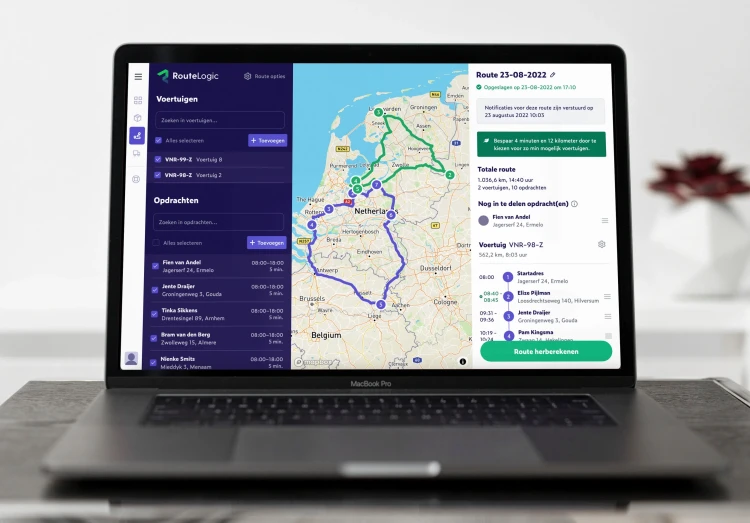ETD (Estimated time of departure), what does it mean?
The meaning of ETD is the estimated time of departure and therefore stands for Estimated Time of Departure, or the estimated time of departure of the delivery person from the warehouse. You can mostly know this term from shipping and/or aviation. However, this term is also useful to use as a courier company. Using route planning software such as RouteLogic, using ETD helps calculate time period delivery and estimated time of arrival.
Let's explain the meaning of ETD using an example. If you expect the driver to leave the warehouse at 09:00, that is the estimated departure time. Using route planning software, you can calculate that if the driver leaves at 09:00 that the driver should be at his first delivery address by 09:30, or the ETA.
Note that ETD is also sometimes used to indicate the estimated time of delivery, or, estimated time of delivery. In this case, the ETD need not be identical to the ETA. We explain this with an example.
If a driver arrives at 14:00 at a flat where he needs to deliver several packages, the ETA is 14:00. But the ETD can be 14:15 because the delivery driver delivers other packages to the flat first.
The difference between ETD and ETA
We understand that using these terms can sometimes be a bit confusing, so we will explain the terms based on some of the differences. So for starters, ETA refers to estimated arrival time, while the meaning of ETD can refer to estimated departure time or estimated delivery time. But when do you use which terms?
- ETA is primarily used to inform customers when to expect their package.
- Estimated departure time is mainly useful for delivery drivers. When there is a certain time when drivers need to start their route to reach all stops within their time period, it is useful to give the estimated departure time. This also makes it clear when adjustments need to be made if the driver leaves the warehouse late.
- The estimated delivery time is useful for time-sensitive packages. For example, suppose a driver has to deliver a package to a customer at 4 p.m., the customer can take this into account and be present when the package is delivered.
By using the ETA and ETD and keeping track of live changes, you ensure that drivers can deliver all packages on time.
What is the difference between ETD and ATD?
You expect the driver to leave the warehouse in the morning at punctual 09:00, then this is the ETD, the estimated departure time. However, when loading the goods, delays occur so the driver ends up not being able to leave until 09:15. Then this is the ATD, the driver's actual departure time.
The importance of accurate ETDs
Accurate ETDs are crucial in the logistics industry. They help optimize route planning and provide more efficient supply chain management. An accurate ETD can help deliver on promises to customers and increase satisfaction. It can also save costs on fuel and personnel by enabling better planning. Monitoring and updating ETDs based on real-time data can help improve the performance of logistics operations.
Technological tools for managing ETD and ETA
Technological advances have led to the development of sophisticated software and applications that help manage ETD and ETA. Route planning software, as mentioned earlier, is just one example. There are also Tracking & Trace systems, GPS technology and telematics solutions that provide real-time information on the location and status of vehicles and shipments. These technologies enable logistics companies to calculate and communicate more accurate ETDs and ETAs, thereby improving service to customers.
ETD in the context of global logistics
The meaning ETD takes on an added dimension when it comes to international or intercontinental shipments. In such cases, ETD plays a crucial role in the coordination between different parties such as shipping companies, airlines, customs and logistics service providers. An accurate ETD is essential for meeting deadlines and avoiding additional costs such as demurrage and detention. Understanding and managing ETD in a global context is an essential part of successfully managing a complex supply chain.
Integration with RouteLogic for optimal delivery forecasts
In today's digital age, it is critical for customers to get real-time updates on the status of their orders. While the ETD is an important indicator for internal logistics planning, it is the ETA (Estimated Time of Arrival) that really interests customers. With RouteLogic, take customer communication to the next level. RouteLogic is an advanced route planning software that can predict the exact ETA with an impressive 98% accuracy, thanks to a unique proprietary algorithm that stands out in the market.
RouteLogic allows the ETA to be communicated directly to customers via SMS and/or e-mail, so they know exactly when to expect their delivery. In addition, RouteLogic's track-and-trace page provides a live view of where the driver is, allowing customers to check the status of their delivery at any time.
RouteLogic also clearly shows the recommended ETD for each route. Drivers are informed by SMS 15 minutes (configurable) before their route is due to start. This ensures fewer delays and an even more accurate ETA. Thus, RouteLogic combines the best of both worlds: internal efficiency by managing ETDs and superior customer satisfaction through accurate and timely ETA communication.



